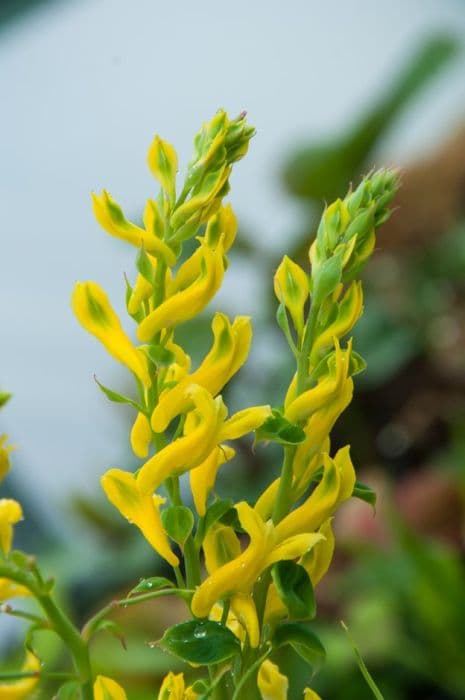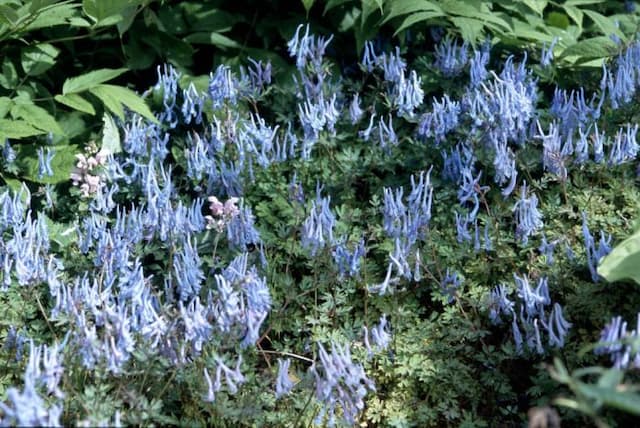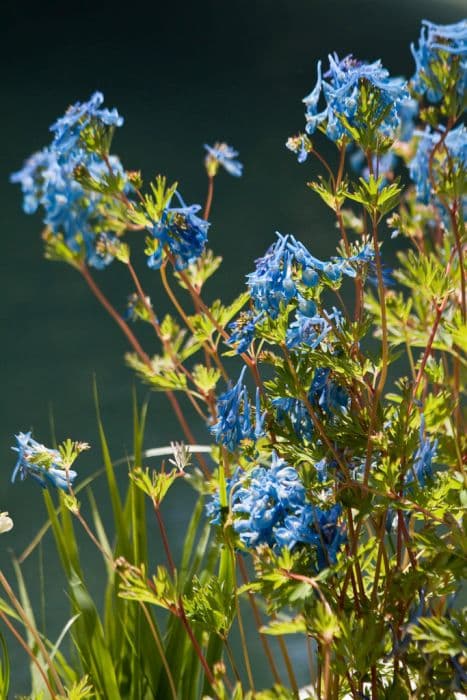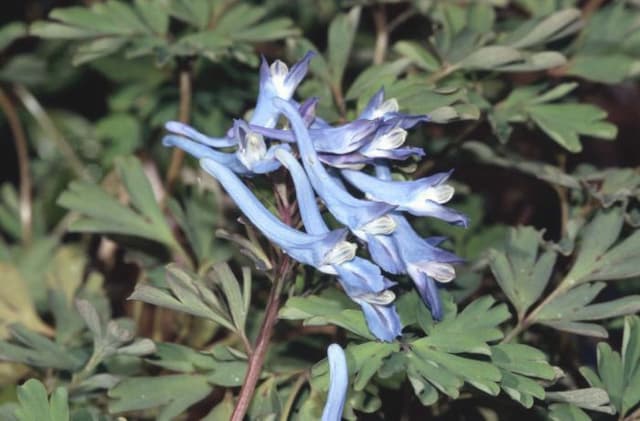Himalayan Blue Poppy Meconopsis (Fertile Blue Group) 'Mop-head'

ABOUT
The 'Mop-head' variety from the Fertile Blue Group of Meconopsis plants stands out with its stunning flowers that are reminiscent of the classic poppy in shape and structure. These blossoms usually display an entrancing shade of blue, a color rarely found in the plant world, often glowing with a vivid intensity that is both eye-catching and ethereal. The petals have a delicate, satiny texture and are arranged in a slightly shaggy fashion, which gives the 'Mop-head' its distinctive appearance. The foliage of the 'Mop-head' consists of leaves that are elongated and may have a toothed edge, commonly demonstrating a lush green hue that contrasts beautifully with the blue flowers. The leaves are typically hairy, providing a slightly rough texture that is characteristic of this group of plants. Flowering typically occurs in spring or early summer, depending on the climate, which allows the 'Mop-head' to stand out in the garden during this time with its remarkable blooms. These plants can form a clump of flowers and foliage, presenting a dense mound of color and texture that adds a unique aesthetic to any landscape where they can thrive. Overall, the 'Mop-head' Meconopsis is admired for its striking blue flowers and attractive foliage, making it a coveted choice for gardeners seeking to add a splash of cool-toned colors to their outdoor spaces.
About this plant
 Names
NamesSynonyms
Fertile Blue Himalayan Poppy, Mop-head Blue Poppy, Mop-head Meconopsis
Common names
Meconopsis (Fertile Blue Group) 'Mop-head'.
 Toxicity
ToxicityTo humans
The Meconopsis, commonly known as the Blue Poppy, is not widely recognized for being toxic to humans. There is no substantial evidence indicating that the Blue Poppy has any toxic effects when touched or ingested. However, as with any plant material, individual allergies or sensitivities could cause mild irritation. If any symptoms occur after handling or ingesting the plant, it is advised to seek medical attention.
To pets
The Blue Poppy, or Meconopsis, does not have a well-documented history of being poisonous to pets. There is limited information available on the plant's toxicity to animals. Generally, it is not considered to be highly toxic to pets. Nonetheless, to err on the side of caution, it is recommended to keep pets from ingesting this or any other unknown plants as they may cause digestive upset or an allergic reaction in some animals. If you suspect your pet has ingested a significant amount of the plant and is showing signs of illness, contact your veterinarian.
 Characteristics
CharacteristicsLife cycle
Perennials
Foliage type
Deciduous
Color of leaves
Green
Flower color
Blue
Height
3-4 feet (0.9-1.2 meters)
Spread
1-2 feet (0.3-0.6 meters)
Plant type
Herb
Hardiness zones
5
Native area
Himalayas
Benefits
 General Benefits
General Benefits- Ornamental Value: The Meconopsis, also known as Himalayan Blue Poppy, is prized for its vibrant blue flowers that add a unique color to gardens and landscapes.
- Attracts Pollinators: It helps in attracting bees and other pollinating insects, crucial for the pollination of plants and overall garden health.
- Cultural Significance: The Himalayan Blue Poppy is often associated with serenity and is popular in botanical and oriental themed gardens, providing a cultural aesthetic.
- Garden Variety: Augments the diversity of a garden with its unique appearance and can be a conversation starter due to its striking color and rarity in temperate gardens.
 Medical Properties
Medical PropertiesThis plant is not used for medical purposes.
 Air-purifying Qualities
Air-purifying QualitiesThis plant is not specifically known for air purifying qualities.
 Other Uses
Other Uses- Due to the Meconopsis' eye-catching blue flowers, it can be used as a natural dye for fabrics, creating a unique blue hue that synthetic dyes may not replicate.
- In arts and crafts, the petals of the Blue Poppy can be pressed and used to decorate homemade paper or in the creation of floral bookmarks, giving an artistic touch with its vibrant color.
- Garden photography enthusiasts often use the Blue Poppy as a subject for macro photography due to its intricate structures and striking blue color.
- The plant can be used in educational settings to demonstrate the process of hybridization and selective breeding to garden clubs and biology students.
- Eco-friendly confetti can be made from dried Blue Poppy petals, providing an environmentally friendly alternative to traditional paper or plastic confetti.
- Culinary presentation can be enhanced using Blue Poppy petals as edible garnishes, adding a splash of color to high-end dishes and desserts.
- Blue Puppy blossoms can be floating in water features, such as bird baths or decorative ponds, adding a natural and colorful enhancement to the water garden.
- Artisanal candle makers sometimes incorporate Blue Poppy petals into their wax for a floral touch, which can be especially appealing when creating nature-themed candle assortments.
- Collecting and framing seed pods from the Blue Poppy can create botanical wall art that offers a rustic and natural aesthetic to home décor.
- In storytelling and role-playing games, the striking appearance of the Blue Poppy can serve as inspiration for fictional plants with unique properties inhabiting imaginary landscapes.
Interesting Facts
 Feng Shui
Feng ShuiThe Himalayan Blue Poppy is not used in Feng Shui practice.
 Zodiac Sign Compitability
Zodiac Sign CompitabilityThe Himalayan Blue Poppy is not used in astrology practice.
 Plant Symbolism
Plant Symbolism- Peace and tranquility: The blue poppy's delicate petals and calming color are often associated with serenity.
- Success: In some cultures, blue poppies symbolize success due to their rarity and the perception that they are difficult to grow.
- Imagination: The unique and otherworldly appearance of the blue poppy is believed to inspire creativity and the imagination.
- Consolation: The rare and gentle beauty of the blue poppy offers a sense of calm and consolation to those who are grieving.
- Mysticism: Their unique color and ephemeral nature lend blue poppies a mystical aura, often connecting them to themes of the unknown or spiritual realms.
 Water
WaterHimalayan Blue Poppies prefer moist soil, so it’s important to water them regularly, especially during dry spells. The goal is to keep the soil evenly moist but not waterlogged. Typically, water with 1-2 gallons per week, depending on rainfall and temperatures. Adjust the amount if rainfall naturally irrigates the plant or if temperatures are significantly higher or lower than average. Overwatering can lead to root rot, so ensure proper soil drainage.
 Light
LightHimalayan Blue Poppies thrive best in partial shade with protection from intense afternoon sun. A spot that receives morning light and afternoon shade is ideal. Avoid deep shade as this can reduce flowering and can cause the foliage to become leggy in search of light.
 Temperature
TemperatureHimalayan Blue Poppies do best in cooler conditions and can survive minimum temperatures down to about 32°F, but prefer a range of 50-65°F. They may struggle in temperatures that consistently exceed 75°F. It is important to protect them from harsh winter winds and excessively hot summer temperatures.
 Pruning
PruningPruning Himalayan Blue Poppies is generally limited to deadheading spent flowers to encourage reblooming and to prevent self-seeding if control is desired. Deadheading can be done throughout the blooming season. At the end of the season, cut back the foliage after it has died down naturally.
 Cleaning
CleaningAs needed
 Soil
SoilThe Himalayan Blue Poppy thrives in a soil mix composed of 50% leaf mold or composted bark and 50% loamy soil, ensuring good drainage and aeration. The soil pH should be mildly acidic to neutral, ranging from 6.0 to 7.0.
 Repotting
RepottingThe Himalayan Blue Poppy should be repotted every two to three years to refresh the soil and prevent it from becoming root-bound. It’s best to repot in the spring before the growing season.
 Humidity & Misting
Humidity & MistingThe Himalayan Blue Poppy prefers a high humidity environment, ideally between 60% to 80%, to mimic their native humid and misty montane climates.
 Suitable locations
Suitable locationsIndoor
Keep in bright, indirect light with high humidity.
Outdoor
Plant in dappled shade, shelter from harsh elements.
Hardiness zone
5-7 USDA
 Life cycle
Life cycleThe life of the Meconopsis 'Mop-head', commonly known as Blue Poppy, begins with the germination of seeds typically sown in cool, moist conditions. Seedlings emerge with a rosette of leaves close to the ground, entering a vegetative growth phase where they develop the root system and foliage. The plant then undergoes a vernalization period, requiring a phase of cold to trigger flowering. After this period, the plant produces tall stems with large, usually solitary blue flowers that bloom from late spring to early summer. Pollination occurs, often with the aid of insects, leading to the development of seed pods that, once mature, release seeds to start a new cycle. The Blue Poppy is a perennial, although it may behave as a monocarpic plant, dying after setting seed, especially if not properly cared for.
 Propogation
PropogationPropogation time
Spring to early summer
The most popular method of propagating the Himalayan Blue Poppy, officially known as Meconopsis (Fertile Blue Group) 'Mop-head', is through seed sowing. The best time to sow these seeds is in late winter to early spring while temperatures are cool, as they require a period of cold stratification to germinate effectively. To propagate by seed, first, chill the seeds in a refrigerator (around 35-39 degrees Fahrenheit or 1.7-3.9 degrees Celsius) for about 4 weeks. Then, sow them on the surface of a moist, well-drained seed starting mix in pots or trays and lightly cover with a fine layer of soil. Place the pots in a cool, bright area but out of direct sunlight, as the seeds need light to germinate. Germination can be erratic and may take 30-50 days, so patience is necessary. Once the seedlings are large enough to handle, transplant them carefully into individual pots and grow them on in cooler conditions until they are ready to plant out after the risk of frost has passed.









